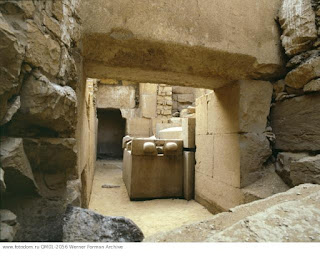Model adze, from a foundation deposit, with blade and handle in copper alloy; roughly made in one piece out of sheet metal; complete but much corroded.
At least six foundation deposits were discovered in Ptolemy II gateway of the Great Temenos, one at each of the four corners and one at the northwest and southwest corners of a central hall (Petrie 1886, 28-31, pl. XXV-XXVI; Weinstein 1973, 376-378, no. 158).
The content of these deposits is purely Egyptian in nature and is very similar to that of Late Period foundation deposits (see for example those discovered at Tell Nebesheh, Gemaiyeni and Tell Defenneh: Petrie 1888, 14-15, 40-42, 54-55, pl. V-VI, pl. XIX and XXI-XXIII). Naukratis foundation deposits can be further compared to several foundation deposits, mainly dated between the reigns of Philip III Arrhidaeus and Ptolemy IV, and discovered in various temple complexes of the Delta, at Coptos and in the Theban region (discussed in: Weinstein 1973, 352-363, Group I).
The foundation deposits of Naukratis provided a wide variety of models of ceremonial instruments and tools. Fourteen were made of copper alloy, ten of stone and four of iron. Three models of adze in copper alloy were discovered in the foundation deposits: one in the north-east corner, one in the south-west and one in the north-west one (Petrie 1886, 31, pl. XXV no. 3). According to Petrie’s list, this object was found at the south-west corner of the pylon.
Models of ceremonial instruments and tools are a customary feature in foundation deposits since the Middle Kingdom. They tend to be of small size and poor quality in the Ptolemaic Period, as during the Late Period (Weinstein 1973, 297, 307-308, 356).
Petrie, W. M. F. 1886, Naukratis. Part I, 1884–5 (Third memoir of the Egypt Exploration Fund), London.
Petrie, W. M. F. 1888, Tanis 2: Nebesheh (Am) and Defenneh (Tahpanhes), London.
Weinstein, J. M. 1973, Foundation deposits in ancient Egypt, Ann Arbor.
British Museum
britishmuseum.org




 and Ipuky
and Ipuky  .
. 

 Samut, aka
Samut, aka  Kyky
Kyky 






























 Djehutyhotep
Djehutyhotep  "Great Chief of the Hare Nome"
"Great Chief of the Hare Nome" 



